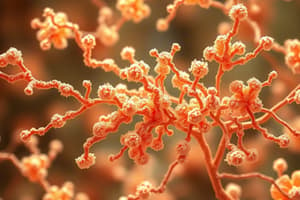Podcast
Questions and Answers
What is the main method used for lab diagnosis identification of C. ulcerans and C. diphtheriae?
What is the main method used for lab diagnosis identification of C. ulcerans and C. diphtheriae?
- ELEK's test (correct)
- Gelatin liquefaction test
- Guinea pig inoculation
- Horse serum agar test
Which sugar is positive in Hiss's Serum sugars test for identification?
Which sugar is positive in Hiss's Serum sugars test for identification?
- Sucrose
- Fructose
- Maltose
- Glucose (correct)
What is the mainstay of treatment for Diphtheria?
What is the mainstay of treatment for Diphtheria?
- Antidiphtheritic serum (correct)
- Clindamycin
- Penicillin
- Erythromycin
Which antibiotic is NOT sensitive for treating carriers of Diphtheria?
Which antibiotic is NOT sensitive for treating carriers of Diphtheria?
What is the purpose of using Guinea pig inoculation in the ELEK test for Diphtheria diagnosis?
What is the purpose of using Guinea pig inoculation in the ELEK test for Diphtheria diagnosis?
What is a general characteristic of Corynebacterium?
What is a general characteristic of Corynebacterium?
Which species of Corynebacterium causes sore throat and ulcers?
Which species of Corynebacterium causes sore throat and ulcers?
What are the biotypes of C. diphtheriae that cause Diphtheria?
What are the biotypes of C. diphtheriae that cause Diphtheria?
Which species of Corynebacterium is known for systemic infections in immunosuppressed individuals?
Which species of Corynebacterium is known for systemic infections in immunosuppressed individuals?
What kind of infection does C. ulcerans typically cause?
What kind of infection does C. ulcerans typically cause?
What is a distinguishing feature of respiratory diphtheria compared to cutaneous diphtheria?
What is a distinguishing feature of respiratory diphtheria compared to cutaneous diphtheria?
What is the major clinical sign of laryngeal diphtheria that can lead to death?
What is the major clinical sign of laryngeal diphtheria that can lead to death?
Which stain is used in the lab diagnosis to stain volutin in Corynebacterium diphtheriae?
Which stain is used in the lab diagnosis to stain volutin in Corynebacterium diphtheriae?
What selective media is used to differentiate Corynebacterium diphtheriae from other upper respiratory tract flora?
What selective media is used to differentiate Corynebacterium diphtheriae from other upper respiratory tract flora?
What is the characteristic morphology observed under microscopy for Corynebacterium diphtheriae?
What is the characteristic morphology observed under microscopy for Corynebacterium diphtheriae?
Which of the following is a major diagnostic criterion for diphtheria infection before the availability of anti-toxin and vaccination?
Which of the following is a major diagnostic criterion for diphtheria infection before the availability of anti-toxin and vaccination?
What differentiates C.diphtheriae from commensal corynebacteria on Hoyle's Tellurite blood agar?
What differentiates C.diphtheriae from commensal corynebacteria on Hoyle's Tellurite blood agar?
Flashcards are hidden until you start studying
Study Notes
General Characteristics of Corynebacterium
- Gram-positive, catalase positive, non-spore-forming, non-motile, rod-shaped bacteria
- Straight or slightly curved shape
- Metachromatic granules are usually present, representing stored phosphate regions
Species of Corynebacterium
- Many species, with most being commensals (diptheroids)
- Human pathogens:
- C. diphtheriae (3 biotypes: gravis, mitis, and intermedius)
- C. hemolyticum (sore throat, ulcers)
- C. jeikium (systemic infections in immunosuppressed, heart valve infections/endocarditis)
- C. ulcerans (pharyngitis, similar to diphtheria)
Diphtheria
- Caused by C. diphtheriae
- Respiratory diphtheria: more serious, fatal if untreated, begins in the upper respiratory tract
- Cutaneous diphtheria: skin infection, wound contaminated with C. diphtheriae, rarely systemic
- Respiratory diphtheria symptoms:
- Throat acute inflammation
- White membrane over the throat
- Can spread down and cause death from asphyxia (Laryngeal diphtheria)
Laboratory Diagnosis
- Specimen: nasopharyngeal swab, wound swab
- Microscopy:
- Gram stain: pleomorphic gram-positive bacilli, gram variable, coryneform (Chinese letter arrangement)
- Special stain: Albert's stain (KLB stain), Malachite Green, and Toludine blue
- Culture:
- Selective media: Hoyle's Tellurite blood agar, Tindale medium
- Characteristic black colonies on blood tellurite agar (C. diphtheriae)
- Gray colonies on Tellurite agar (commensal corynebacteria)
Identification and Virulence Testing
- Biochemical tests:
- Hiss's Serum sugars: glucose and maltose positive, sucrose negative
- Urease positive: C. ulcerans
- Gelatin liquefied: C. ulcerans and C. diphtheriae
- Virulence testing:
- ELEK's test (Ag-Ab test)
- Guinea pig inoculation
Treatment of Diphtheria
- Mainstay of treatment: Antidiphtheritic serum (antitoxin)
- Antibiotics used for:
- Treatment of carriers
- Synergistic with antitoxin for patients
- Sensitive to Erythromycin, Penicillin, and Clindamycin
Studying That Suits You
Use AI to generate personalized quizzes and flashcards to suit your learning preferences.




